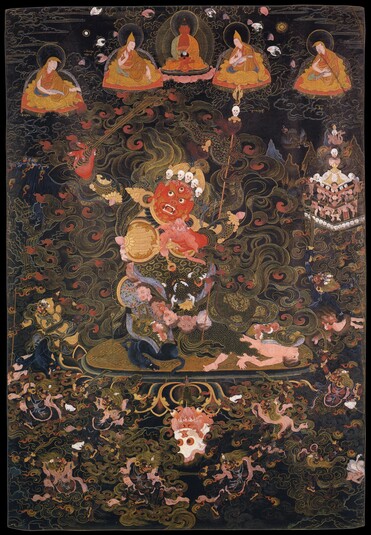
Item: Begtse Chen (Buddhist Protector)
| Origin Location | Tibet |
|---|---|
| Date Range | 1700 - 1799 |
| Lineages | Gelug and Buddhist |
| Material | Ground Mineral Pigment, Black Background on Cotton |
| Collection | Museum der Kulturen, Basel |
Classification: Deity
Begtse Chen (English: the Great Coat of Mail. Sanskrit name: Prana Atma), was popularized within the Sarma (new) Schools of Tibetan Buddhism by Marpa Lotsawa (1012-1096) and Sachen Kunga Nyingpo (1092-1158), the respective founders of the Marpa Kagyu and Sakya Traditions of Tibetan Buddhism. Colloquially Begtse is known as red Mahakala and ranks relatively high in the Sakya protector pantheon of Wisdom Deities. However, in the various Kagyu Traditions it is now rare to even find Begtse Chen. The protector was later adopted and incorporated into the Gelug School of Tsongkapa and subsequently became popular in Mongolia - predominantly following the Gelug tradition since the 17th century. The majority of Begtse Chen art objects currently known were created within a Gelug context and many of them are of Mongolian origin.
Begtse Chen is the main protector associated with the Hayagriva cycle of Tantric Deity meditation practice. For over one hundred years Western scholars have published the history of Begtse erroneously as beginning with the 3rd Dalai Lama and the subjugation of a Mongolian war god - referring to the protector deity Begtse. A common source given for the Western account of the story, based on Mongolian oral history, is Albert Grunwedel (1856-1935). In Tibetan Buddhism Begtse is believed to have originated in India. The practice entered Tibet with Nyen Lotsawa in the 11th century.
Begtse Lineage: Dharmakaya Amitabha, Sambhogakaya Hayagriva, Nirmanakaya Padmasambhava, Mahasiddha Darchar, Bodongpa Tsundru Dorje, Nyenchen Sonam Tenpa, Khenchen Chogyal Pal Zangpo, Kunkhyen Palden Sengge, Dragram Kashi Chenmo, Tsarchen Dorjechang Losal Gyatso (1502-1566), Jamyang Khyentse Wangchug (1524-1568), [etc.].
Jeff Watt 5-98
Buddhist Protector: Begtse Chen (Masterworks)
Buddhist Protector: Begtse Chen Main Page
Painting Type: Black Ground Masterworks
Painting Set: Gelug Protectors (Purbu Chog)
Collection of Essen, Museum der Kulturen (Painting Masterworks)
Buddhist Protector: Begtse Chen Religious Context
Collection of Essen, Museum der Kulturen, Basel (Painting)


